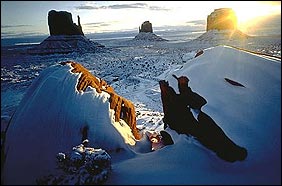Search
San Juan County

In prehistoric times the San Juan County was the home of the Anasazi, until about 1300 AD. Their cliff houses, pictographs and petroglyphs continue to baffle and fascinate archeologists and tourists. The Navajo Indians, who were latecomers to the area, now occupy a large part of San Juan County from the San Juan River to the Arizona border. In 1879, the Mormon scouts who planned the famous Hole-in-the-Rock Trail that year began settling along the river. Early cattlemen like the brothers Al and Jim Scorup did better in the rough canyon country than the farmers. Gradually, settlements formed in the high country around the Abajo Mountains in the towns of Blanding and Monticello.
A gold rush on the San Juan River in the early 1890s was short-lived but miners eked a living from deposits they discovered along the river bars. The uranium boom of the early 1950s brought a population rush to this remote corner of Utah. Today, numerous oil and gas wells dot the landscape above the productive Aneth field.
Canyonlands National Park, Rainbow Bridge, Glen Canyon National Recreation Area and the white-water rapids of the Colorado and San Juan Rivers attract thousands of visitors and make up a thriving tourism industry

